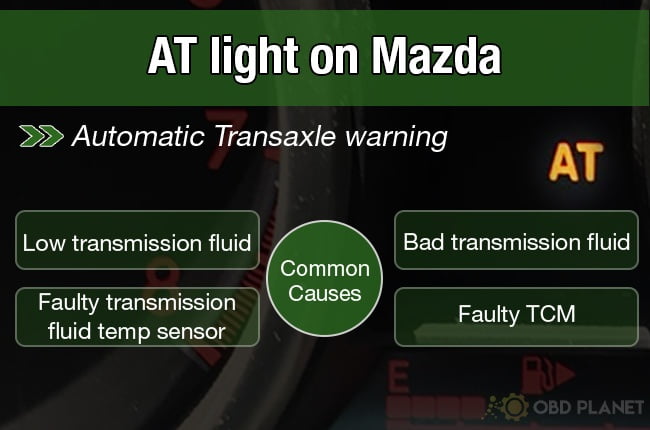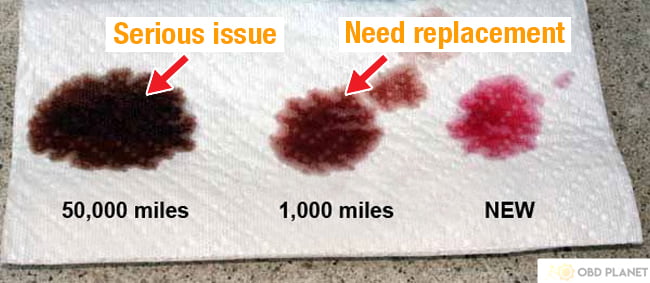Is your Mazda’s AT light switched on and you’re not sure what it’s all about? Are you hearing weird noises while driving and feeling a bit concerned?
I suggest you address this sooner rather than later and if necessary, fix it ASAP, or you may end up having to pay big money for transmission damage in the near future – not a road you want to go down!
Don’t panic though! This article will help you with:
- What the AT light means
- How you can diagnose the issue yourself
- How much it’ll cost you
Let’s get into it!
What does the AT light mean?
An AT light is found in all Mazda vehicles and stands for “Automatic Transaxle”. Having an illuminated AT warning light could mean a few things like low transmission fluid, dark color old/bad transmission fluid, or something else (more seriously) wrong with the transmission system.

If your Mazda vehicle has an illuminated AT light, first, I would suggest you check out the transmission fluid for its:
- Level
- Color
Low transmission fluid – Most common cause for AT light
Transmission fluid is responsible for lubricating the transmission. It also keeps the transmission system cool, ensuring the longevity of the vehicle.
Low transmission fluid is the leading cause of an illuminated AT light in your Mazda. And that’s the first thing you need to check.
Signs to look for
To help you diagnose your Mazda’s AT light problem, here are a few symptoms of low transmission fluid:
- Noises (whining, humming)
- Burning smell
- Slipping gears
How to fix
Just top up your vehicle with transmission fluid! Here’s how you can check and add the transmission fluid yourself!
However, watch out for leaks!

To locate a leak, check the pan gasket and the bolts around it (and a few other things may need to be inspected, but these two are the most common issues).
Loose bolts from an earlier transmission fluid change can cause leaks. Make sure to tighten the bolts on the pan gasket.
You may find that the bolts are tight. In that case, there might be a crack in the gasket or some other damage that means it may require replacement.
Large cracks would require replacing the gasket. It’s actually quite easy to do, and if you’re willing to get your hands a little dirty, you can totally replace the pan gasket at home by yourself and save some money. Here’s how:
You may also be able to fix minor leaks from the gasket by using transmission stop leak fluid. It is a great solution to help seal up minor leaks in a transmission system.
Below are two great options worth trying out if you have a minor leak:


How much does it cost?
Topping up your transmission fluid is inexpensive. Depending on the brand, you may be looking at around $20 – $50 per gallon of transmission fluid. Using transmission stop leak fluid for minor leaks is an additional $10 to $12.
Replacing gaskets is relatively cheap as well and will cost you $20 to $45. However, taking the vehicle to a mechanic to replace the gasket will cost upwards of $150 with labor costs, so trying to tackle this yourself may be worthwhile if you’re looking to save a few dollars.
Dark-color transmission fluid
If the transmission fluid level is OK, the next thing you will want to check is its color.
Following the instruction of the video above, you can also check for the transmission fluid color. There are 3 basic transmission fluid colors you’ll get:
- Bright red (Right-hand side of the picture below): The fluid is good. The problems causing the AT light must be something else.
- Dark red (Middle of the picture below): You need to change the fluid.
- Brown or black (Left-hand side of the picture below): At this point, something bad might have already happened to your transmission system. A complete transmission flush is the first step (very risky, you should let a mechanic decide if your car needs that or not). If that isn’t viable or doesn’t work, you may unfortunately be looking at a rebuild, and a very large bill to go along with it…
Replacing the oil filter is another common solution. But if this still doesn’t stop the symptoms (highly likely when the fluid is very dark or completely black), you may unfortunately need to rebuild the whole transmission.

How much does it cost?
| Transmission fluid color | Solutions | Cost (labor included) |
|---|---|---|
| Dark red | Transmission fluid change | $80 - $250 |
| Brown | Transmission flush | $100 - $200 |
| Brown | Oil filter replacement | $250 - $340 |
| Brown, black | Transmission rebuild | $1,200 - $5,000 |
Use OBD2 scan tool – Most effective option to turn AT light off
If there is no issue with transmission fluid, then you may have a bigger problem.
To diagnose the potential problems with your car, you can use an OBD2 scan tool. The device will tell you the fault code(s), which will indicate the issues causing the AT light to illuminate.
The bad news is that a cheap OBD2 scanner can only pull codes from the engine module. However, the AT light comes from the transmission module, so you’ll need something a little more advanced than a $30 code reader (but thankfully not too much more advanced).
An excellent option that will be able to access the transmission module of your Mazda (along with many other manufacturers) is the BlueDriver OBD2 Scan Tool, a very reasonably priced device that I am comfortable recommending to almost anyone – it’s super easy to use and provides a lot of valuable information.

The BlueDriver can access the transmission control module in all Mazda vehicles and pull the codes for you. Even if you cannot fix the problems, it’s always wise to bring your vehicle to a repair shop having a pretty good idea of what’s truly wrong with your car first, so you don’t get ripped-off!
How to use OBD2 scan tools on Mazda
If you’re new to this, don’t worry, they’re very easy to use. Here’s how:
Common transmission fault codes causing the AT light to come on
As a mechanic, whenever my Mazda customers have an illuminated AT light, I’m about 90% sure something on the list below will be at fault.
P0218: This refers to an overheated transmission due to low or dirty transmission fluid. However, if the transmission fluid is okay, there may be an issue with the temperature sensor.
P0613: This code tells you that there is a fault within the circuitry or the processor. A mechanic should be able to fix this in no time. But it’s probably going to be quite expensive as it is quite specialized.
P0614: This code indicates that the Engine Control Module (ECM) and Transmission Control Module (TCM) are incompatible with each other. This could perhaps be due to a recent change in any of these components resulting in incompatibility issues.
P0700: The most common cause for this code is a faulty TCM. Usually, when your car has this code, the check engine light will also come on.
P0706: The transmission range sensor communicates with the TCM letting it know the shifts of the gear lever. It also confirms whether or not the gear is in neutral for the car to be able to start. An issue with the transmission range sensor will bring up this code.
P0715: Your automatic transmission vehicle constantly sends signals to the TCM. It lets the processor know if the car is in the right gear. This code could be due to a corroded wire or may require input speed sensor replacement.
P0720: Your speedometer reads the speed using speed sensors. It lets the TCM know how fast the input shaft is moving. If you’re having a boggy speedometer, you may see this code. It’s time for an output speed sensor replacement.
P0729-P0736: This range of codes all indicate the same error – gear issues. The different codes represent the specific gear/s having the problem. Usually, a simple transmission fluid top-up should fix this issue. However, if you still see these codes, there may be an issue with the torque converter. You may also see this code in conjunction with other codes. It can point to a corroded solenoid that helps regulate the torque converter clutch.
P0750-P0770: The TCM lets the transmission know when to shift gears by opening up solenoids. Doing so allows the transmission fluid to pass into the gear. You may see these codes in tandem with other P codes. It could be a solenoid failure. In such circumstances, one or more of your gears may not work and you may have difficulty shifting into or out of certain gears.
How much does it cost?
Usually, one code may have a number of different causes, and of course, different solutions. So, in the below table, although these common solutions may not always be the only ones, I would say that these are generally the common fixes for these codes.
| Codes | Cost (labor included) |
|---|---|
| P0218 | Replace transmission temperature sensor: $230 - $310 Replace faulty TCM: $500 - $900 |
| P0613 | Replace faulty TCM: $500 - $900 |
| P0614 | Replace faulty ECM: $900 - $2,000 Replace faulty TCM: $500 - $900 |
| P0700 | Repair valve body: $320 - $900 Replace TCM: $500 - $900 Replace transmission: $1,200 - $5,000 Replace solenoid: $150 - $400 (Single unit) |
| P0706 | Replace transmission range sensor: $249 - $285 Replace PCM (Rare): $500 - $1,500 |
| P0715 | Replace transmission speed sensor: $800 - $1,000 Replace transmission valve body: $400 - $850 Replace solenoids:$150 - $400 (Single unit) |
| P0720 | Replace transmission speed sensor: $800 - $1,000 Replace PCM: $500 - $1,500 |
| P0729-P0736 | Replace valve body: $320 - $900 Replace TCM: $500 - $900 Replace transmission: $1,200 - $5,000 Replace solenoids: $150 - $400 (Single unit) |
| P0750-P0770 | Replace solenoids: $150 - $400 (Single unit) Replace transmission fluid: $80 - $250 |
Conclusion
An illuminated AT light is a common issue among Mazda car owners. It requires proper diagnosis and fixes to avoid any further damage to your transmission system. Don’t ever ignore the AT light, or you’ll likely end up paying a much higher price down the line.
Whether you have a lot of experience in car repairs or not, getting an OBD2 scanner is never a bad idea. It could save you thousands of dollars in the future.
And whatever the codes and symptoms you’re having, don’t forget to leave a comment below. I’ll try my best to help you out.



I have this code from my 2010 mazda mx5.
2721-FF
What do I do?
Thanks
Hi Jeevaraj. Code 2721 normally relates to the pressure control solenoid “D” control circuit. If you are having issues changing into or out of certain gears, this could mean that you have an issue with one of your transmission solenoids or related fuses, or perhaps the TCM itself has a problem. I wouldn’t suggest trying to tackle this issue by yourself unless you have experience in this area, and taking it to a reputable mechanic or auto shop near you is definitely a better bet, as getting it wrong could end up causing serious damage to your transmission which could prove very costly. Inform them of the code that you have been presented with and the issues you are having with your car. They should be able to check it out and will be able to advise you better.